Order of St. Andrew
| Order of St. Andrew the Apostle the First Called Орден Святого апостола Андрея Первозванного | |
|---|---|
 | |
| Awarded by | |
| Type | Military and Civilian Order |
| Established |
Original: 1698 Re-establishment: 1998 |
| Eligibility | Prominent State and Public Figures |
| Awarded for | Outstanding Service to the State |
| Status | Active |
| Grades | Knight |
| Post-nominals | KA |
| Precedence | |
| Next (lower) | Order of St. George |
|
Ribbon of the Order of St. Andrew the Apostle the First Called | |
The Order of St. Andrew the Apostle the First-Called (Russian: Орден Святого апостола Андрея Первозванного) is the highest order of the Russian Federation. Established as the first and highest order of chivalry of the Russian Empire in 1698, it was abolished under the USSR before being re-established as the top Russian order in 1998.
Russian Empire
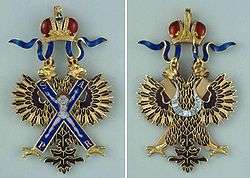
Origins
The Order was established in 1698 by Tsar Peter the Great, in honour of Saint Andrew, the first apostle of Jesus and patron saint of Russia. It was bestowed in a single class and was only awarded for the most outstanding civilian or military merit.
Peter learned of the practice of bestowing awards from his travels in the West during the Great Embassy. In the past, service to the Russian state was rewarded with money or large estates. He witnessed first hand the awards ceremonies for England's Order of the Garter and Austria's Order of the Golden Fleece and noticed the loyalty and pride of the awardees. It also saved the state land and money.
Count Fyodor Golovin was the first recipient of the order. Until its abolition following the Russian Revolution of 1917, just over one thousand awards had been made. During the monarchy, recipients of the Order of St. Andrew also automatically received the Order of St. Alexander Nevsky, the Order of the White Eagle, the Order of St. Anne first class, and the Order St. Stanislaus first class. Moreover, recipients of lower ranks were automatically promoted to the rank of lieutenant general or vice admiral. The Order of Saint Andrew continued to be awarded by the Russian Imperial House in exile. The first post revolutionary presentation was to HH Prince Georgy Konstantinovich of Russia on attaining his dynastic majority in April 1923.[1]
Insignia

The insignia of the order consisted of:
- Badge: an enameled crowned black double-headed eagle bearing a blue St. Andrew's Cross (saltire) with St. Andrew crucified upon it; on the arms of the saltire were the Latin letters 'SAPR' ('St. Andrew, Patron of Russia'). It was worn on a pale blue sash over the right shoulder, or on special occasions on an elaborate 'collar' (chain).
- Star: eight-pointed silver star bearing a miniature of the badge on a golden background at the center, surrounded by the motto "For Faith and Loyalty" (Russian: Za Veru i Vernost) on a blue ring. It was worn on the left chest.
The insignia of the order could be awarded "with diamonds" as a special distinction. Saint Andrew's Cathedral in Saint Petersburg was the chapter church of this order of chivalry.
Recipient of Order of St. Andrew the Apostle the First-Called uses the post-nominal letters "KA". When an individual is entitled to use multiple post-nominal letters, those of the Order of St. Andrew the Apostle the First-Called appear before all others, except for the International Orders of the equal status to the Order of St. Andrew, that was created before 1698 (creation date of the order Imperial Order of St. Andrew). For example, if one is awarded Order of the Garter, in that case, post-nominals of "KG" (Order of the Garter) used before "KA" (Order of St. Andrew) because the Order of the Garter has been created in 1348.
Recipients (partial list)
- Count Feodor Golovin
 Tsar Peter the Great
Tsar Peter the Great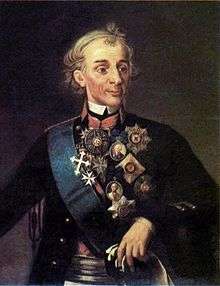 General Alexander Suvorov
General Alexander Suvorov Prince Dmitry Golitsyn
Prince Dmitry Golitsyn
Russian Federation

An order with the same name but with different insignia and statutes was first unofficially re-established by the Orthodox Church of Russia on December 27, 1988. The order was officially re-instated as the highest Russian civilian and military award by Presidential Decree №757 on June 1, 1998.[2] The Order's award criteria were modified by Presidential Decree 1099 of September 7, 2010.[3]
Statute of the Order
The Order of St. Andrew the Apostle the First-Called is used to award prominent statesmen and public figures, eminent representatives of science, culture, the arts and various industries for exceptional services, for promoting the prosperity, grandeur and glory of Russia.[4]
The Order may also be used to award foreign heads of states for outstanding service to the Russian Federation.[4]
Unlike the original Imperial institution, the modern Order does not have special robes nor strict rules regulating its wearing. The collar, the sash and the star of the Imperial Order were only worn with uniform or full evening dress; the insignia are nowadays worn on lounge suit and at least one recipient was seen wearing the order dressed in lounge suit without a tie, something that would be unheard of during the Imperial era. The collar of the original Order was worn across the shoulders; modern recipients tend to wear it as a chain around the neck.
Insignia
The design of the insignia of the modern Order of St. Andrew has changed very little from the imperial design. It consists of:
- a badge (double-headed eagle) attached to a chain (called a "collar") worn around the neck for very special circumstances, or more commonly on a 100mm-wide blue sash worn over the right shoulder
- a star worn on the left breast
The colour of the sash differs from the colour of the Imperial era, and resembles the shade of the sash of the British Order of the Garter. Members of the military division of the Order have crossed swords added below the crown above the two eagles' heads. On the reverse of the eagle on a white ribbon the motto of the Order appears inscribed in gold letters: «За веру и верность» ("For faith and loyalty").[4]
Recipients (partial list)
Among the recipients of the Order after its re-establishment were:[5]
 Author Aleksandr Solzhenitsyn
Author Aleksandr Solzhenitsyn Author Sergey Mikhalkov
Author Sergey Mikhalkov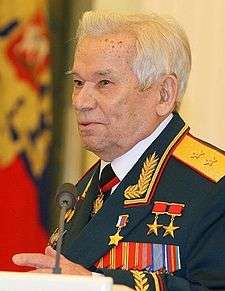 Gun designer Mikhail Kalashnikov
Gun designer Mikhail Kalashnikov Mikhail Gorbachev, last general secretary of the CPSU
Mikhail Gorbachev, last general secretary of the CPSU
 Valery Shumakov, founding father of organ transplants in Russia
Valery Shumakov, founding father of organ transplants in Russia
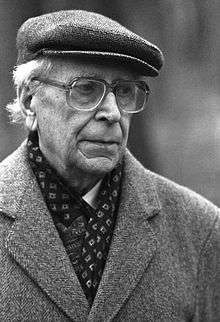 Soviet Russian scholar Dmitry Likhachov
Soviet Russian scholar Dmitry Likhachov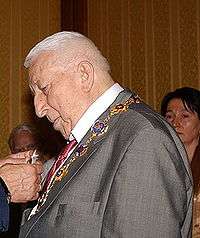 Poet Rasul Gamzatov
Poet Rasul Gamzatov
See also
References
- ↑ ru:Пожалования титулов и орденов Российской империи после 1917 года
- ↑ "Decree of the President of the Russian Federation of June 1, 1998, No 442" (in Russian). Commission under the President of the Russian Federation on state awards. 1999-12-15. Retrieved 2012-02-11.
- ↑ "Decree of the President of the Russian Federation of September 7, 2010, No 1099" (in Russian). Russian Gazette. 2010-09-07. Retrieved 2012-02-11.
- 1 2 3 "Statute of the Order of St. Andrew the Apostle" (in Russian). Commission under the President of the Russian Federation on state awards. 1999-12-15. Retrieved 2012-02-11.
- ↑ "Compiled from the site of the President of the Russian Federation" (in Russian). Kremlin News. Retrieved 2012-02-07.
External links
- The Commission on State Awards to the President of the Russian Federation
- Order of St Andrew ARCHONS of the Ecumenical Patriarch
